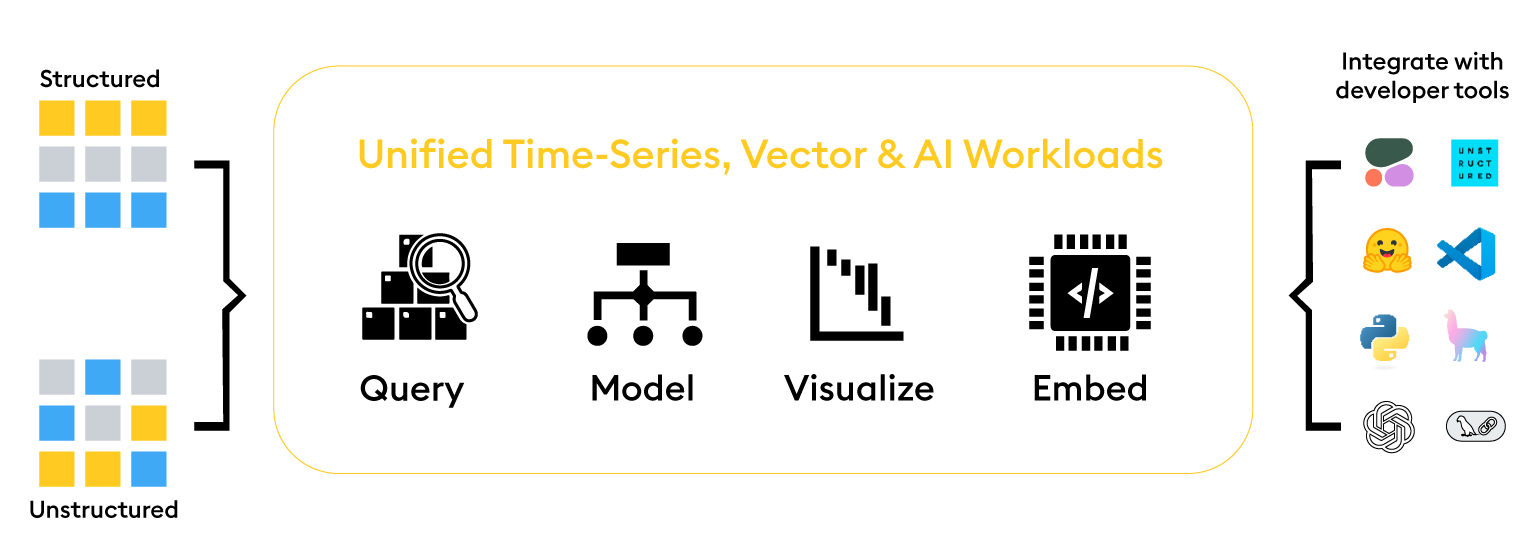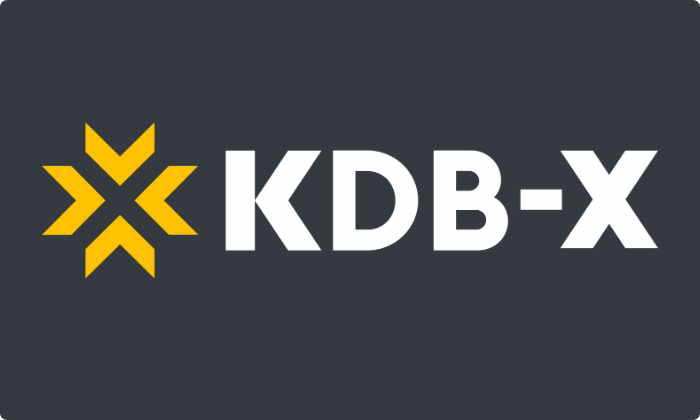Key Takeaways
- KDB-X unifies time-series, vector, and AI workloads in one high-performance platform.
- A modular architecture lets teams plug in Parquet, REST, Object Storage, and AI libraries as building blocks.
- Native support for Python, SQL, and q delivers full interoperability across data science and engineering workflows.
- Built-in GPU acceleration (Spring 2026) and the MCP Server enable AI-assisted querying and large-scale model execution.
- Optimized for speed and scale, KDB-X handles petabyte-level workloads with benchmark-leading performance.
Built on the trusted core of kdb+, KDB-X brings together time-series, vector, and AI workloads in a single open, high-performance platform.
For more than three decades, kdb+ has supported the fastest and most data-intensive environments. It set the standard for time-series analytics, holds industry-leading benchmarks, and remains the primary engine behind many of the world’s major trading, risk, and research systems in capital markets.
Today, we bring kdb+ into the modern AI era with KDB-X: a unified compute engine that integrates time-series and vector data within a single analytics platform. Firms can now consolidate their stack and bring their data, compute, and AI workloads into a single environment specifically built to handle the demands of capital markets. With this release, KDB-X is now available, and you can get started for free with our Community Edition from our Developer Center.

Trading systems are at a crossroads with many changes and challenges to conquer: data sources are expanding, market feeds now sit beside alternative and unstructured content, AI models are moving from experiment to production, workloads run across CPUs, GPUs, cloud, and on-prem systems, while more team members require access to data. Firms need a practical way to keep performance consistent as their data and compute footprints grow, while allowing more users access to maximize operational efficiency.
With AI-assisted research, agentic workflows, and GPU processing becoming standard, trading and research teams need infrastructure that bridges established analytics with newer forms of computation and democratizes access to interact with their data.
For quants and engineers, this means faster model development and deployment. For data and technology leaders, it means updating long-standing systems while keeping performance and control.
KDB-X offers a unified data stack with an open, modular architecture that supports interoperable data formats (Parquet), programming languages (Python, SQL), and built-in AI capabilities, including GPU acceleration, to deliver nanosecond multi-modal data analytics across your structured and unstructured data.
As mobile devices once combined several tools in one, KDB-X brings storage, analytics, and compute into a single environment. This reduces duplication and allows faster delivery of new ideas.
A natural evolution of kdb+
KDB-X keeps everything customers value about kdb+ and extends it to new workloads and users. It retains the same core engine for batch, streaming, and real-time analytics, while unifying time-series, vector, and AI data. With backwards compatibility, existing code and data remain compatible, giving current users a direct route to modernization.
Accessibility
- Commercial, free Community Edition to test, explore and build solutions within minutes
- Comprehensive developer tooling to expedite time to value
- Thorough documentation and a robust developer community
Extensibility
- Module framework and library management for faster, standardized development
- Integrated support for ML and AI workflows
- Ecosystem of open-sourced libraries for community innovation
Interoperability
- Native support for open data formats
- Developer choice: Python and q alongside SQL and REST
- Support for “fusion” libraries to enable broader compatibility
Built on openness and extensibility
KDB-X follows three principles: accessibility, extensibility, and interoperability. It connects with the tools, formats, and workflows firms already use. Open interfaces and modules let teams begin with a small setup, add capabilities easily, and expand as needs change. Whether installed beside an existing kdb+ system or within a larger data platform, KDB-X connects consistently and avoids lock-in.
Built for the world’s most demanding data environments
KX has worked with the world’s most data-heavy enterprises for decades. With KDB-X, that experience now extends across structured and unstructured data, historical and live workloads, and both CPU and GPU processing.
It is designed to handle petabyte-scale data when required and remains lean at smaller scales where microsecond latency matters most. Benchmarks using the TSBS DevOps suite compared KDB-X with QuestDB, ClickHouse, TimescaleDB, and InfluxDB under identical hardware and dataset conditions. KDB-X was faster in over 90 percent of test cases, including both short-range and multi-year workloads, and achieved that performance while using only a small portion of the available compute resources (read more about these benchmarks here).
Unified, open, and built for developers
The foundation of KDB-X enables teams to run tick replay, vector search, or model scoring within the same environment using a single data model and shared memory management.
Getting started is simple, as KDB-X can be installed within minutes using a single command, and users can choose to interact with data with the languages they already love, like q, Python, or SQL.
KDB-X’s modular framework keeps functionality portable and reusable. Teams can add or share modules with minimal effort and drastically reduce their development cycle with KX and Open-Source modules. For example, users can leverage their existing data ecosystem with the Parquet module and query it alongside kdb+ data in a single instance.
With the vector data now on a unified platform, use AI libraries to query unstructured data alongside structured time-series data for holistic analytics, and leverage GPU Acceleration to unlock unprecedented speeds (Spring 2026).
Provide end-to-end analytics by using our MCP Server integration to directly connect to popular AI clients and assistants, like ChatGPT and Claude, with full enterprise governance to provide natural language querying of data to all users with an organization. The ability to capitalize on high-volume, high-velocity, and varied data is easier than ever.
What can firms do with KDB-X?
Early adopters are already showing what this step forward enables.
- End-to-end TCA on Parquet, in place: Compute arrival and VWAP slippage, venue performance, and broker analytics directly on Parquet or Iceberg data using native q or SQL. Enrich live trades with TAQ or OPRA, futures ticks, reference data, and corporate actions, then run governed as-of joins while storing only what is required.
Outcome: faster iteration, lower pipeline overhead, consistent governance. - Hybrid vector and time-series search: Store embeddings beside telemetry or market features, shortlist with vector similarity, then verify with temporal shape matching, such as DTW, within the same runtime.
Outcome: fewer false positives in surveillance and anomaly detection, faster signal validation. - Agentic AI on live data with auditability: Subscribe to real-time streams, join with historical context, run models in q or Python, and trigger actions within one auditable system. MCP ensures each AI assistant or model references the same governed data.
Outcome: shorter path from insight to action, simpler architecture, clear audit trail. - GPU-accelerated retrieval and scoring: Store embeddings and features together, using optional GPU processing for approximate nearest-neighbour search or model inference (Spring 2026).
Outcome: higher throughput for AML, surveillance, or real-time risk with fewer moving parts.
These examples show how a single architecture broadens what is practical in production.
Getting started
KDB-X is the next logical step for firms that already trust kdb+, engineered for the realities of today’s markets and ready for the intelligence-driven infrastructure of tomorrow.
KDB-X is available now, and you can start building today for free with the Community Edition from our Developer Center.
To explore the technical capabilities in detail, including modules, AI libraries, and benchmark results, read the launch blog from our Developer Relations team.






